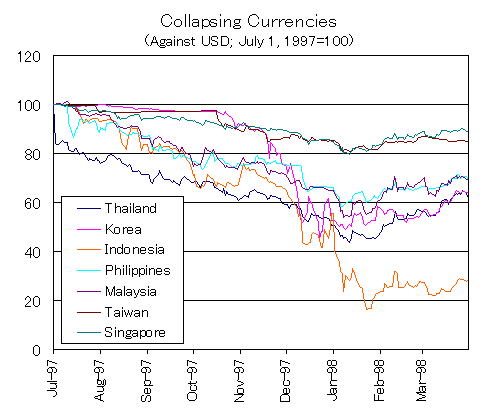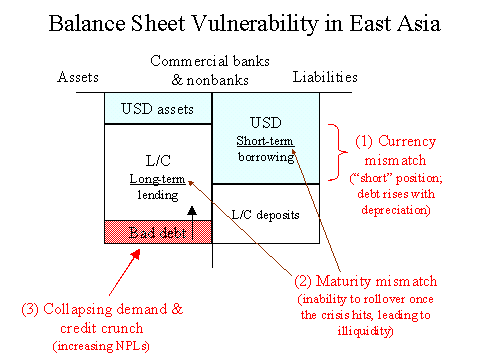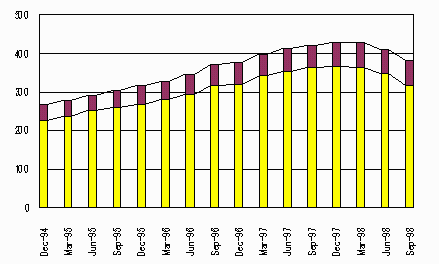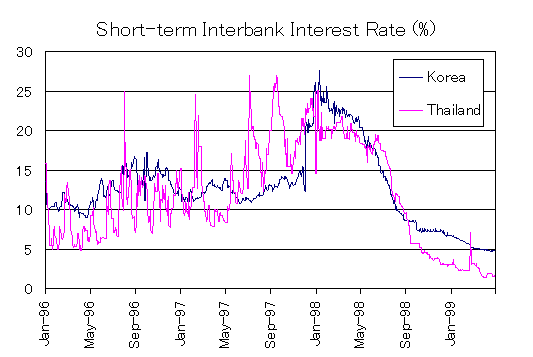
(See handout nos.10&11(&17); reading Yoshitomi-Ohno)
The remainder of the course, including this lecture, deals with the question of how to manage the macroeconomy (especially the exchange rate) in the age of global financial integration in order to promote economic stability and avoid unnecessary shocks to the home country. We first deal with the Asian crisis which broke out in July 1997.

Note: The currencies of China and Hong Kong remained unchanged against USD during this period.
Many things have already been said about the Asian crisis (1997-98). By now, the impact of the Asian crisis is over. Some of the things that were said initially did not stand the test of time, and were forgotten. The cry of "crony capitalism" as the cause of the Asian crisis is no longer very convincing after the crisis spread to the non-Asian world and the irregularities of American business and accounting practices are also exposed.
So, what are the remaining lessons of this crisis? Economists do not agree on this and every person is free to form his or her opinion. But there seem to be two generally accepted lessons that merit our attention.
The macroeconomic and financial lesson
The first interpretation of the Asian crisis is macroeconomic and financial. As noted in the previous lecture, many developing and transition countries opened up financially by the early 1990s and became "emerging markets" attracting foreign loans and investments. In developing East Asia, short-term commercial bank loans were the dominant form of capital inflow (Asian securities markets were underdeveloped). At first, this caused domestic booms and asset market inflation. But later, as the market sentiment turned for the worse and foreign investors pulled their money out, the balance of payments came under a severe pressure. Speculative attacks rapidly depreciated Asian currencies, and the illiquidity problem--inability to rollover the short-term bank loans since foreign banks demanded immediate repayment--occurred. The domestic banking sector froze up and domestic demand fell sharply, causing a serious recession that lasted for one to two years.
This macro shock was amplified by the balance-sheet vulnerability caused by the weaknesses of Asian banks, nonbanks and corporations. Firms in developing East Asia were (are) highly dependent on indirect finance (i.e., bank loans) for working and investment capital and had high debt/equity ratios. Moreover, the local banks and nonbanks were exposed to two kinds of balance-sheet mismatches. They borrowed in USD and lent to domestic projects in local currency (currency mismatch). In addition, they borrowed in short term loans but lent to long-term domestic projects (maturity mismatch). When the currency depreciation began, the balance sheets of these financial institutions were immediately hit and bad debt increased. When foreigners demanded repayment, they had no foreign cash. This is a liquidity problem, but as the crisis deepened, it created insolvency as well.
In addition, the collapsing domestic demand, which was caused by panic, credit crunch (malfunctioning of the banking sector) and wrong policy prescriptions (in some countries), damaged the real sector and led to the accumulation of bad debt. This further deteriorated the quality of the balance sheets of financial institutions.

According to this view, the Asian crisis was primarily caused by the wrong speed and sequencing of external financial liberalization. Countries liberalized capital accounts too quickly and without preparation, which caused overborrowing and bubbles. Furthermore, the government did not properly monitor what was happening. The lesson therefore is: you must open up your financial sector gradually and in the right order. The pace of financial liberalization must match the pace of strengthening the domestic financial sector and the monitoring capability. The government must make utmost effort to improve domestic banks and securities, but this will take time. A big bang liberalization is dangerous and irresponsible.
China, India, Vietnam, Myanmar and Cambodia were not affected by the Asian crisis as much as Korea and ASEAN4 (Thailand, Indonesia, Philippines Malaysia). This is not because the productivity and financial institutions of the first group were superior. In many ways, their domestic systems are much worse than Korea or ASEAN4. They were not directly hit because they did not open up financially.
The structural lesson
The second interpretation of the Asian crisis is structural. On the surface, it is true that this crisis was a macro and financial phenomenon involving banks, nonbanks and borrowers. But deeper down, according to this view, the real cause was the structural weaknesses of the developing economies in East Asia. As long as these weaknesses remain, similar crises can occur in the future. The real solution must be the removal of these structural weaknesses.
However, one problem with this interpretation is that there are different views as to what exactly was the structural weakness(es) that caused the Asian crisis? For example, the following candidates are often mentioned:
--The banking problem and the lack of proper bank supervision [this is the same as the first interpretation]--Pre-modern corporate sector: non-transparency, family dominance, non-separation of ownership and management, archaic accounting, etc.
--Unhealthy relationship between the government and big business (Korean chaebol; corporate groups in Indonesia, Thailand, etc.)--Real-sector problems in productivity and competitiveness: low technical absorption, lack of competent professionals and managers, lack of supporting (parts) industries, etc.
--Heavy dependence on exports (especially on US markets and IT products)--Political backwardness and lack of true democracy
As an example, the World Bank report East Asia: Recovery and Beyond (June 2000) argued that East Asian countries would not continue to recover unless they improved in three areas: (i) managing globalization; (ii) revitalizing business; and (iii) forging social contract and role for government. Among these, "revitalizing business" means dealing with the under-capitalization of banks and high indebtedness of corporations, and reducing the government ownership of banks and corporations which were temporarily nationalized after the crisis.
In normal times, it is difficult to introduce bold structural reforms because of political resistance of interest groups. But when a crisis occurs and people expect changes, it may be politically easier to implement such reforms. Some people call this the "window of opportunity" [in Japanese, we say the "opportunity of one thousand years"]. Whether these structural problems were the true cause of the Asian crisis is less important than the fact that necessary reforms can now be implemented with popular support. Maybe it was a good thing that the Koreans began to criticize the triangular relationship among government, banks and chaebol (big business groups like Daewoo, Samsung, LG...), sell domestic banks to foreigners, and so on.
But you must also be careful about the other risk--of doing too much. It is hard to know which system works in your country and which does not. The evolution of social and economic systems is unique to each country and very difficult to predict or evaluate. In the excitement of post-crisis confusion, a country may adopt new systems without much deliberation. It may accept American systems or IMF conditionality too uncritically, but they may not fit your social needs. This is called "throwing the baby out with the bathwater." [The German philosopher Friedrich Nietzsche also said: "Beware that in casting out the devil, you may cast out the best part in you !"] Didn't chaebol contribute greatly to the Korean economic development in the past? Are you sure they are no longer needed?
The lesson is that post-crisis reforms for overhauling your society should be well balanced. You should take advantage of the impetus for reform that the crisis has brought, but you must also be cool-headed about the scope and speed of the change. You should not "reform" in order to revenge and penalize big businesses.
In the rest of this course, let us continue to analyze the Asian crisis from the macroeconomic and financial viewpoint. From the historical perspective, what was so unique about the Asian crisis?
Currency crises are very common phenomena. Balance-of-payments pressure and currency overvaluation, followed by speculative attacks and a large depreciation, occur all the time. A 30% nominal fall of the home currency is normal in such a crisis. Sometimes it falls 50% before rebounding. If it falls 75% or more, we can say that it is a rather severe crisis (Indonesia in 1997, Russia in 1998, ...)
The Asian crisis was a twin crisis in the sense that it was simultaneously a currency crisis (externally) and a banking crisis (internally), with the two crises reinforcing each other. This is more damaging than a currency crisis only. But even twin crises are not rare. They happen often.
What distinguishes the Asian crisis of 1997-98 from other crises is perhaps its length and severity. It was not just one country or two that were affected, but the whole region suffered simultaneously. Contagion was very strong. Moreover, as the Asian crisis triggered similar crises in other regions (Russia, Brazil, Turkey, Argentina...), the crisis even led to the rethinking of the global financial system itself. Its cause was clearly bigger than the policies of affected countries. Economists and officials began to suspect that this kind of crisis was inherent in unstable private financial flows. This prompted a discussion of reforming global financial architecture.
The current account crisis is a traditional crisis with which the IMF is well acquainted. It is caused by inappropriate macroeconomic policy of the government and leads to the balance-of-payments crisis. Its sequence is typically as follows:
(1) A budget deficit is monetized (i.e., financed by central bank credits) and inflation occurs.
(2) A current account deficit rises and international reserves decline.
(3) The country experiences difficulty in international payments and goes to IMF.
(4) Tight budget and money, together with structural adjustment (liberalization and privatization), are required as the conditionality for international rescue. The home currency is devalued to regain competitiveness.
In general, macroeconomic tightening and economic liberalization are the right policy response to a current account crisis, although the speed and timing of implementation must be judiciously chosen so as not to unnecessarily damage the economy and people's living standards.
The capital account crisis is a new type of crisis caused by the instability of private capital flows. It is often observed immediately after the liberalization of the capital account.
(1) External financial transactions are liberalized in a country where the domestic banking system is underdeveloped and the monitoring system is weak.
(2) Domestic banks, nonbanks and corporations overborrow, and foreign investors and banks overlend.
(3) A domestic boom, asset bubbles and an increase in international reserves are observed.
(4) Reversal comes. Market sentiment changes for the worse and foreign investors suddenly leave. Currency attacks begin. A huge and uncontrollable depreciation follows.
(5) A severe macroeconomic downturn occurs as demand collapse and banking crisis reinforce each other.
One salient feature of the capital account crisis is that there are two distinct phases: up and down. At first, capital flows in, the domestic economy is stimulated, and everything looks rosy. But after the reversal, economic confusion is inevitable at least for one or two years. As to the current account crisis, there is no such break; the problem--overspending--basically remains the same throughout.
These two crises, which require very different policy responses, should be clearly distinguished. The Asian crisis was a capital account crisis. The big problem was that policy prescriptions for a current account crisis was administered to this crisis. This was a mismatch between reality and policy (see below).
Thailand, Korea and Indonesia were especially severely hit by the Asian crisis and they asked IMF for help. The Philippines and Malaysia were also badly affected--but not as severely as the above three. In all of these countries, credit crunch was experienced and non-performing loans (NPLs) mounted.
Credit crunch is a situation where banks stop lending to firms even though there is a legitimate demand for credit. It is a temporary breakdown of the functioning of the banking system. If this happens, even sound firms cannot operate due to the lack of financing, and a recession may be generated. But the precise definition and measurement of credit crunch is operationally difficult.
One problem is the difficulty in distinguishing a supply-driven credit decline and a demand-driven one. Even if bank lending goes down, this may be due to falling credit demand at the time of recession--banks may be functioning properly and want to lend but cannot find good projects or customers. If so, it is the recession that causes a credit fall, not vice versa.
Another problem is that credit crunch may affect different firms differently. Typically, large firms and foreign firms are not very gravely affected by the shortage of bank credit, because they can use retained profits, issue corporate bonds or equity, or borrow from abroad. But small and medium firms are more directly impacted by a credit crunch. Thus, demand-driven credit decline and supply-driven credit decline may occur simultaneously in different segments of the economy. While big firms' appetite for bank credit falls in recession, small firms are unable to get loans even if they want to.
In developing Asia, firms depended heavily on bank loans since local securities (bond and equity) markets were under-developed. This exacerbated the crisis as the banking sector came to a standstill. At the time of the Asian crisis, many studies were conducted to examine the existence and severity of credit crunch in the crisis-hit countries. They included bank surveys, corporate surveys, and econometric works. But no clear conclusion or consensus emerged.
The World Bank-coordinated national surveys of corporations in the five severely hit countries in 1999 showed that credit crunch (or illiquidity) was not a big problem in any of these countries; the biggest problem rather was the lack of domestic demand (i.e. recession). But many economists said that this result was unconvincing, because:
--There is a sampling bias (a number of severely affected industries, such as construction, trade and services, were not included in the survey).--The survey date was too late (end 1998-early 1999); by that time, the crisis was more or less over.
--The winners' bias: only those firms which survived the crisis were surveyed. Weaker firms were already eliminated so they could not be included in the sample.--Governments provided policy loans to ameliorate the credit shortage, so the survey result may indicate the success of this policy rather than the absence of the illiquidity problem.
Japan's Exim Bank conducted a bank survey in Thailand during 1997-98, and found severe cases of credit crunch--contrary to the World Bank result.
I visited Korea to look into this matter in early 1999. I asked economists in the Bank of Korea, KDI, KIEP and IMF; professors at Seoul National University and Yonsei University; officials at Financial Supervisory Service, etc. All of them were very polite and helpful, but their opinions were sharply divided. Some argued that credit crunch was very severe and blamed the IMF for causing it (see below). Others said that Korea did not have a credit crunch at all. Some said monetary policy was too tight during the crisis while others said that policy stance was adequate.
Korea: Bank and Nonbank Loans to the Private Sector
(In millions of won)Credit stagnates--is this demand-driven or supply-driven?
(Yellow: loans for working capital. Purple: loans for capital investment)

Note: Credits from all financial institutions, including nationwide commercial banks, regional banks, foreign banks, special banks and nonbanks.
During and after the Asian crisis, IMF was severely criticized for inappropriate policy advice. According to the critics, IMF made two big errors:
Ex ante (before the crisis)--IMF failed to prevent the Asian crisis. In fact, it created the conditions for such a crisis by encouraging financial opening to the countries which were not ready for it.Ex post (after the crisis)--IMF failed to contain the Asian crisis after it erupted. In fact, many contend that the crisis was aggravated and prolonged by IMF's wrong policy advice.
In the ex post response to the crisis, what exactly was the problem? The following three points can be raised:
(1) IMF demanded tight budget and money, although domestic demand was collapsing. This worsened the recession even more. After several months, IMF changed its advice and permitted the crisis-hit countries to take more expansionary fiscal and monetary policies.(2) IMF demanded high interest rates to attract back foreign capital and stop the currency depreciation. But this worsened the balance-sheet problem and credit crunch of affected banks and firms.
(3) IMF ordered banking and corporate reforms during the height of the crisis. Many argue that such reforms should be implemented after, not during, the crisis. Closure of weak banks in Indonesia during the panic, which led to further bank runs, was particularly harshly criticized.
It appears that the IMF administered the "current account crisis" medicine to the "capital account crisis" problem. The Japanese Ministry of Finance began to criticize the IMF (Minister Kiichi Miyazawa and Prof. Takatoshi Ito). Many Japanese economists echoed (including Shinji Takagi, Eiji Ogawa, Kenji Aramaki, Masaru Yoshitomi, and myself). Jagdish Bhagwati, Jeffrey Sachs, S. Jomo (University of Malaya), and many others outside Japan also severely criticized the IMF.
Joseph Stiglitz (former World Bank chief economist and now at Columbia University) wrote scathing articles against IMF, and even wrote a book about it (see below). He said that during the Asian crisis, the IMF economists, including the former IMF chief economist Stanley Fischer, were too arrogant and incapable, and took the wrong policies and worsened the crisis.
At first, the IMF (1999) replied that all policies they had implemented were basically right from the beginning. They refused to apologize. But slowly, they started changing policies not to repeat the same mistake. In 2003, the Independent Evaluation Office of IMF issued a report which recognized more frankly that the Fund's policy design and implementation in Indonesia, Korea and Brazil was inappropriate (IMF 2003). By now, IMF perhaps will not tighten budget or money, or ask for immediate structural reforms when a similar crisis occurs in the future. But they may not have relented on the issue of high interest rate policy.
After the Asian crisis, the IMF has also worked on the policy of private sector involvement (PSI). This means that, when a crisis occurs, foreign private investors should not be allowed to pull out their money freely; instead, they should be asked to stay, rollover the debt, and take some losses. The IMF also seems now to understand that a big financial rescue package was needed upfront and unconditionally, rather than conditionally and in small installments, when a crisis like this occurs.
What should have been done, ideally, at the time of the Asian crisis? As a general principle, we can say as follows:
--The priority should be stopping the regional currency crisis; structural reforms should be undertaken later, not during the crisis. Put out the fire first, investigate the cause later.--Don't apply "current account crisis" measures.
--Calm the market. This is a delicate psychological game against market traders, and you must know very well how financial markets work. Timing and sequencing are the key.
We recommend the appropriate combination of the following international measures (some of these measures may not have to be implemented depending on the situation):
| 1 | A big emergency money should be offered, immediately and unconditionally |
| 2 | Private sector involvement (PSI)--see above |
| 3 | Joint intervention to support and stabilize regional currencies |
| 4 | Regionally coordinated fiscal and monetary expansion |
In addition, the following domestic measures should be taken as necessary:
| 5 | Unlimited and unconditional provision of liquidity (this is called the lender of last resort (LLR) function of the central bank) |
| 6 | Compulsory bank recapitalization (with forced restructuring later) |
| 7 | Temporary suspension of banks' capital adequacy standards |
| 8 | Provision of emergency credit through public channels |
 |
 |
| Stanley Fischer (1943-), former IMF chief economist | Joseph Stiglitz (1943-), former World Bank chief economist |
As noted above, the appropriateness of the IMF policy in maintaining high interest rates during the currency rout is in question.
Stan Fischer and the IMF report (1999) defended this policy by saying:
--High short-term interest rates are absolutely necessary to stop sharp currency falls.--This may hurt domestic banks and enterprises, but there is no other alternative.
--Interest rates will eventually fall after the currencies stabilize.
But Stiglitz, Sachs and many others disagreed:
--Asian banks and enterprises had balance-sheet vulnerability, which was worsened by high interest rates.--Asia's problem consisted of short-term bank loans which foreign banks refused to roll over. This situation was not improved at all by raising securities market interest rates (interest rates were irrelevant to the question of whether foreign banks will roll over the existing debt).
--Raising interest rates in such circumstances undermines confidence further, and aggravates the crisis.
Which side is right? This is largely an empirical question. So K Ohno, K Shirono (my former Japanese research assistant) and E Sisli (my former Turkish research assistant) performed Granger-causality tests to see if interest rates had any impact on exchange rates during the Asian crisis. Our empirical results based on daily data were supportive of the view that high interest rate policy was counter-productive. The causality from interest rates to exchange rates completely evaporated during the height of the crisis (July 1997-January 1998), exactly the period when high interest rate policy was supposed to be working. Instead, mutual causation among Asian exchange rates as well as influences from Japanese and American financial markets increased after July 1997.
This result is consistent with the idea that all Asian exchange rates were driven by external common influences (global market sentiment?) rather than domestic policies in individual crisis-hit countries.

<References>
International Monetary Fund, IMF-Supported Programs in Indonesia, Korea, and Thailand: A Preliminary Assessment, January 1999.
International Monetary Fund, The IMF and Recent Capital Account Crises: Indonesia, Korea, Brazil, Evaluation Report of the Independent Evaluation Office, 2003.
McKinnon, Ronald I., The Order of Economic Liberalization: Financial Control in the Transition to a Market Economy, 2nd edition, Johns Hopkins University Press, 1993.
Ohno, Kenichi, Kazuko Shirono and Elif Sisli, "Can High Interest Rates Stop Regional Currency Falls?" ADB Institute Working Paper no.6, December 1999. paper graphs [also downloadable from ADBI web].
Pattillo, Catherine, Helene Poirson, and Luca Ricci, "External Debt and Growth," IMF Working Paper WP/02/69, April 2002. paper
Stiglitz, Joseph E., Globalization and Its Discontents, W.W. Norton & Company, 2002.
World Bank, Private Capital Flows to Developing Countries: The Road to Financial Integration, Oxford University Press, 1997.
Yoshitomi, Masaru, and Kenichi Ohno, "Capital-Account Crisis and Credit Contraction: The New Nature of Crisis Requires New Policy Responses," ADB Institute Working Paper no.2, May 1999 [in assigned paper package].